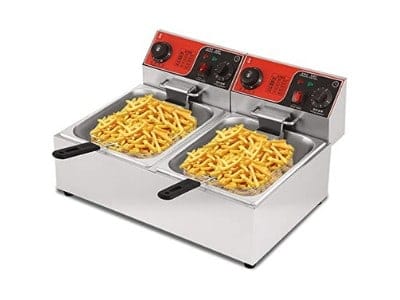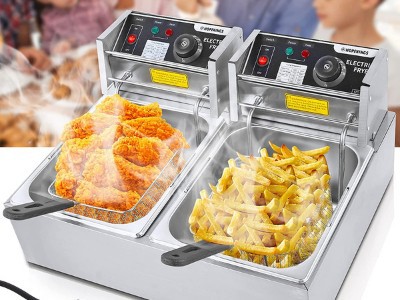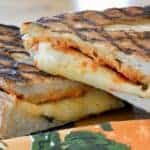Restaurants and commercial kitchens…
…often use commercial deep fryers to prepare appetizers and specific entrees.
Deep fryers cook food efficiently and quickly.
The oil medium in a deep fryer is heated to around 400 degrees Fahrenheit…
…by a heating element. T
he moisture inside the food product boils when it is dipped into the oil…
…but because oil and water do not mix, the product does not lose moisture…
…but rather, is steamed from the inside out.
Here’s your buying guide for commercial deep fryers…
…beyond these great deep fryer basics.
Cho has some words to say…
My deep fryer, which I just bought, hasn’t been used very much yet,
but when it has, I’m pleased with it.
It is definitely larger than I expected.
It would be better suited for a commercial business than for home use.
So far, I’m happy with it.
Now let’s get started…
Introduction to Deep Fryers

A deep fat fryer is almost a necessity if you want to satisfy…
…the enormous demand for fried foods…
…like French fries and fried chicken (such as nuggets, fingers, and wings).
However, a commercial deep fryer can also…
…be a very versatile piece of restaurant equipment.
By offering your customers fried appetizers, entrees, side dishes, and desserts…
…you can diversify and embellish your menu or maximize check totals.
Check-Building Fried Foods
- Appetizers: fried cheese sticks, shrimp, fish nuggets, calamari, onions, mushrooms, egg rolls, dumplings, wontons, tortilla chips, vegetables such as string beans, cauliflower, zucchini, broccoli, and more.
- Entrees: fried fish, shellfish, cutlets, chicken-fried steak & chops, chimichangas, falafel, samosas, and more.
- Side Dishes: Fried onion rings, plantains, kale, tater-tots, pickles, okra, hush puppies, fried mac ‘n’ cheese, corn-on-the-cob, and more.
- Garnishes: fried onions, leeks, shallots, herbs (leaf basil, sage, and rosemary) root vegetables (shoestring parsnips, sweet potatoes, and carrots), coconut shavings, and more.
- Desserts: fried pies, doughs, fritters, funnel cakes, churros, and a host of novelty items like fried ice cream, butter, Twinkies, Snickers, Oreos, cheesecake, and more.
Furthermore, deep frying is a relatively fast cooking method…
… and fried foods tend to travel well.
You can maximize your take-out and delivery business with them.
Whether it’s fried chicken, French fries, or fresh doughnuts…
…fried items have been a staple of some of the most successful fast food chains ever.
Here’s the main part…
Buying Guide for Commercial Deep Fryers

What Are You Frying?
The first question to ask when shopping for a commercial fryer is:
What will you be frying? Commercial deep fryers usually fall…
…into one of three categories.
Specialty fryers are also available for certain applications.
Primary Commercial Fryer Types
- Open-vat Fryers – Despite their versatility and suitability for most frying needs, open-vat fryers are best suited to unbreaded or lightly breaded foods like French fries, chicken wings, egg rolls, hush puppies, and cheese sticks. The “open-vat” refers to the unobstructed heating area inside the fryer pot. These fryers are generally inexpensive and easy to clean. There is a “cold zone” at the bottom of the fryer pot, where sediment and food particles can settle out without continuing to cook and degrade the oil. In open-vat fryers, the cold zone tends to be narrow. If you fry foods heavily coated in batter or bread crumbs, it quickly overflows.
- Tube-type Fryers – Tube fryers have a larger cold zone that traps more sediment and food particles, so they are a better choice for heavily breaded items such as chicken, fish, or onion rings. Fryers in tubes can accomplish the same tasks as open-vat fryers, but they are more difficult to clean. The oil is heated by a series of tube-shaped heating elements that are permanently affixed near the bottom of the fryer pot, and special brushes may be required to clean around and beneath the tubes.
- Flat-bottom Fryers – It is best for delicate or specialty items that float near the surface, such as tempura, taco shells, and funnel cakes. These fryers have a shallow, open bottom. As they lack a sediment zone, they are not ideal for high volume tasks.
Specialty Fryers
Some fryers are designed for specific tasks.
A conveyor fryer is suited to high-volume production.
Once the product is cooked, a conveyor belt…
…raises it out of the tank on the other end.
These special doughnut fryers are designed…
…to produce high volumes of doughnuts efficiently.
In corndog fryers, special clips hold onto the wooden stick…
…while submerging just the cornbread coated hotdog into the pot.
You can find small countertop fryers…
…for small operations, light duty, or specialty items.
Finally, pressure fryers are almost exclusively used for frying chicken.
They are ideal for fast food fried chicken operations…
…due to their combination of higher temperatures, faster speeds…
…moisture retention, and tumbling action inside the fryer tank.
How Much Are You Frying?

Your choice of fryer depends on how much you plan to fry.
The Right Size Commercial Fryer
In an effort to provide a comparable standard…
…many manufacturers size their fryers in terms of “pounds of fries per hour.”
If you know how many pounds of product you consume in a typical shift…
…you can calculate your needs and round up to allow for growth and busier times.
A manufacturer’s fryer is also sized according to how much oil it holds.
Countertop models are typically capable of holding between 10 and 30 pounds of oil.
Floor models typically hold between 40 and 100 pounds of oil.
The pounds of oil can be multiplied by 1.5 to 2.0…
…to estimate how much food can be produced in an hour.
A 40-pound fryer should be able to fry 60 to 80 pounds of food per hour…
…while a 100-pound fryer should be able to fry 150 to 200 pounds of food per hour.
It’s not an exact science, and the results may vary…
…depending on the starting temperature of your food (refrigerated or frozen).
It may also differ depending on the size and density of your food.
Fillets of fish, shrimp, and tortillas cook faster than thicker and denser foods…
…like whole chicken parts or steak fries.
The Right Number Of Fryers
As well as fryer size, consider fryer number.
Imagine you serve 200 pounds of food per hour…
…but roughly a third is chicken, a third is French fries, and a third is fish.
Different types of food cooked in the same fryer can transfer unfavorable flavors.
You should fry chicken separately from seafood.
You should fry vegetables separately from meat.
If you serve various food items from different categories on your menu…
…it may be best to buy three smaller fryers and install them side-by-side…
…than to purchase one large high capacity fryer.
Keep reading…
Electric Or Gas Fryer?

Whether to go with an open-vat fryer, tube fryer…
…or flat-bottom fryer depends on your utility costs and availability in your area.
Gas Fryers
Gas fryers tend to heat up more quickly.
A natural gas fryer may also be less expensive to operate in your area…
…depending on natural gas prices and availability.
In open-vat gas fryers, a gas burner heats the fryer pot from above and outside.
Gas burners are housed inside the tubes at the bottom of tube type fryers.
Electric Fryers
When electric fryers reach their optimal cooking temperature…
…they tend to hold that temperature better than gas fryers.
The reason electric fryers are more efficient…
…and typically easier to move is that they are not directly connected…
…to a utility gas line. For cleaning, open-vat electric fryers…
…typically have an electric heating element…
…inside the fryer pot that can be removed.
Energy Efficiency
Thanks to infrared technology, insulated fryer pots…
…heat reclamation technology, and advanced burner design…
…commercial deep fat fryers are more energy efficient than ever before.
Gas and electric models are now available with Energy Star ratings.
A commercial deep fryer can save significant amounts of energy…
…and in some jurisdictions Energy Star rebates are available…
…when qualifying units are purchased.
“The decision will largely be economical. In most parts of the country, gas is less expensive than electricity, so electric models are more costly to operate. You should also consider where the gas lines are in your establishment, as electric fryers are more portable. In many cases, the limitations of the building will make the decision for you.”
Chef’s Toy
Is There Room Under The Hood?
A fryer produces heat, smoke, grease-laden air, steam, odors, and flue gasses.
Any commercial fryer, whether gas or electric, requires adequate ventilation.
Type I Hoods
Type I Hoods meets local code requirements…
…for grease removal and fire suppression.
A broiler is used above cooking equipment…
…such as a range, oven, grill, griddle, and fryer.
Generally, they are wall or ceiling mounted fixtures…
…that have baffles for removing grease.
The buildings also have ductwork and fans that vent exhaust outside.
Ventless Fryers
The number of ventless fryers is growing.
A hood system mounted above the fryer pot is typically included with these units.
To scrub, clean, and cool fryer exhaust…
…they use multiple filters and a technology similar to catalytic converters in cars.
The ventless fryer, and other ventless appliances, are ideal for installations…
…where it is not permitted or practical to install traditional ceiling ventilation.
In high-rise buildings, historical buildings, mall kiosks…
…and kitchens with low ceilings, they’re commonly found.
In addition to being more expensive than conventional fryers…
…they often cost less than installing a new or additional Type 1 hood system.
Go on…
Who Will Operate Your Fryers?
How many workers do you have on hand, and what is their skill level?
The technology behind fryers has evolved…
…and several manufacturers offer highly automated fryers.
Tending The Fryer
Conventional, commodity fryers may do little more than heat oil.
Consistently good results require the attention and skill of an experienced fry cook.
Fryers with more advanced features feature lights…
…or alarms that indicate when the oil has reached…
…the proper cooking temperature or when the cooking cycle is complete.
The control panel of some fryers allows you…
…to enter multiple cooking programs to accommodate various types of food.
There are even models that have automatic lifts…
….that lift the fryer baskets out of the oil at the end of the cooking cycle.
When not in use, automatic shut-offs turn fryers off…
…or set them to idle to conserve energy.
Automated fryers offer reliability, quality…
…and consistency, while using fewer or lower-skilled employees.
Filtering The Oil
As fryer oil degrades due to water, food particles, oxygen, and heat…
…it must be filtered periodically.
Filtering by hand can be messy, unpleasant, and even dangerous.
Training and supervision are often required…
…to get the job done right and on time.
Filtering preserves the flavor and quality of your food.
It also prolongs the life of your oil.
Buying commercial fryer oil can represent a significant food cost…
…so frequent filtering will maximize your return.
In more automated fryers, the oil can be drained…
…filtered with on-board filters, and refilled and topped off…
…in minutes by pressing a button.
Furthermore, they can be programmed to filter at predetermined intervals.
By doing so, we are able to produce great fried foods with less time, labor, and skill.
Even though these units are more expensive initially…
…they pay for themselves in terms of food quality, oil savings, and reduced labor costs.
Low Oil Volume Fryers
For many of the reasons mentioned above…
….low oil volume fryers are becoming more popular.
They can produce the same amount of food in the same amount of time with less oil.
This is achieved by having a shallower fryer pot with a smaller cold zone.
Food quality and cooking speed are maintained with less oil…
…and labor thanks to frequent and fast automated filtration of the smaller cold zone.
Perhaps you are wondering…
What Kind Of Fryer Accessories Do I Need?
There are a variety of accessories that make fryer operation and maintenance easier.
- Frying Baskets – Most fryers use fryer baskets that are filled with product and lowered into the oil. Multiple baskets may fit in a single fryer. By keeping extra baskets on hand, you can pre-fill baskets during busy shifts so that they are ready to be dropped as soon as the previous batch is finished.
- Skimmer – Using a handled screen allows you to remove sediment and food bits from the fryer pot.
- Thermometer – For checking oil temperatures if a fryer thermometer is not built in, a fryer thermometer is necessary.
- Cleaning Solution – To clean a fryer after the oil has been removed, special solutions are available. A pot is filled with water and cleaner, and the heat is turned on to “boil out” the fryer, removing dirt and grease.
- Cleaning Brushes – When cleaning a fryer, fryer brushes will help you scrub the walls and the tubes.
- Filters – You will need to purchase some type of filtering equipment if your fryer does not come equipped with on-board filtration.
How Much Does A Commercial Fryer Cost?
The cost of a commercial fryer depends greatly on its size…
…features, manufacturer, and level of automation.
In comparison, a high end fully featured model might cost thousands of dollars…
…while a no-frills commodity floor model fryer might cost just a few hundred dollars.
You should recognize, however, that the more expensive fryer…
…might actually save you money over time.
Depending on your volume, a low oil volume fryer…
…can save thousands of dollars in annual oil costs.
An energy-efficient model can save hundreds in annual utility bills.
By using a highly automated unit, you can save on labor costs…
…and maintain a high level of food quality…
…which will attract more customers and keep them coming back.
Furthermore, a durable, high-quality unit from a reputable manufacturer…
…can save you a lot of money in maintenance and replacement costs.
Our Articles About Commercial Deep Fryers
Commercial Deep Fryer Safety Tips For You
It’s not easy to operate a commercial deep fat fryer!
If you work in the restaurant industry…
…however, your deep fat fryer is likely an essential piece of kitchen equipment…
…that you use on a regular basis.
Our commercial deep fryer safety tips can help you delight your customers…
…with delectable treats while staying safe at work…
…whether you’re cooking up the perfect corn dog, donut…
…French fries, mozzarella sticks, or countless other delicious treats.
How To Use Commercial Deep Fryer – Super Guide For You!
If you are going to have a restaurant or a bar…
…or if you want to cook for friends or family…
…you may want to consider to use commercial deep fryer.
And of course you want to the best commercial deep fryer right?
They help you keep food fresh as they keep the temperatures very hot…
…and use plenty of oil to keep the food cooked properly.
Read the article to find out more about this topic!
How to Clean a Commercial Deep Fryer You Need To Know!
Deep fryers are essential for adding flavor…
…and texture to favorite foods in restaurants and food service operations.
However, if fryers are not cleaned on a regular basis…
…the delicious crunch may be compromised.
Cleaning and maintaining your deep fat fryers properly…
…will ensure that your customers have a delicious…
…and safe dining experience every time they visit.
Cleaning commercial deep fryers…
…on a regular basis has an added operational benefit: energy savings.
Carbonization on the walls and coils of fryers makes machines…
…work harder to heat up. It saves energy, time, and money to keep them clean.
Sum Up!
You run a popular American steakhouse or flagship burger joint.
The crowd keeps growing, and everyone is craving fresh french fries…
…or a platter of chicken tenders.
There’s a lot going on in your kitchen…
…and your commercial fryer is at the center of it all.
During lunch rush, a commercial fryer is key to many kitchens…
…depending on the type of food you’re cooking.
However, not all fryers are built the same.
You can choose from a variety of frypots, fuel options, capacities,…
…and even specialty fryers for items such as funnel cakes.
Conclusion
Modern commercial kitchens need deep fryers…
…because they are versatile and essential pieces of equipment.
Deep fried foods can be prepared quickly and are generally easy to prepare.
A menu with fried appetizers, sides…
…and desserts can boost check averages since fried foods travel well.
Design and manufacturing technologies have significantly lowered user costs…
…resulting in higher margins on fried food sales.
Take frying into account when running your commercial foodservice establishment.
Our Latest Post:
- Zest Up Your Dishes: Exciting Substitutes For Lemongrass Unveiled!
- Why Your NutriBullet Stopped Working – Unveiling Solutions
- Griddler Showdown: Cuisinart Griddler Deluxe vs Elite – Which is Better?
💻 Use Commercial Deep Fryers| Commercial Deep Fryer Safety Tips| Maintain Commercial Deep Fryer
Was this helpful?
Hi there! I’m a food enthusiast and journalist, and I have a real passion for food that goes beyond the kitchen. I love my dream job and I’m lucky enough to be able to share my knowledge with readers of several large media outlets. My specialty is writing engaging food-related content, and I take pride in being able to connect with my audience. I’m known for my creativity in the kitchen, and I’m confident that I can be the perfect guide for anyone looking to take their culinary journey to the next level.








